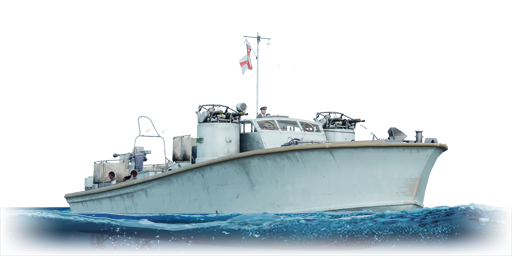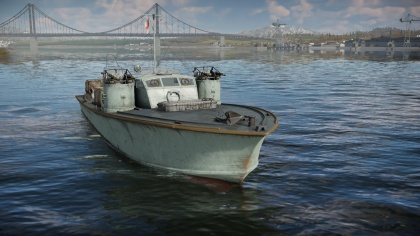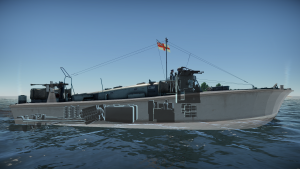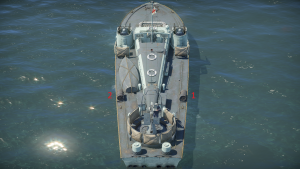MGB-61
Contents
Description
The 70 ft MGB-61 is a rank British motor gun boat
with a battle rating of (AB), (RB), and (SB). It was introduced in during the Closed Beta Test for Ground Forces before Update 1.41. It was introduced in Update 1.83 "Masters of the Sea" as part of the British fleet closed beta test.
General info
Survivability and armour
MGB-61 has the following armour layout:
- 2pdr Rolls Royce gunshield: 12.7 mm hardened armour
- Hull: 40 mm, wood
- Superstructure: 15 mm, wood
Any gun in the game will easily be able to penetrate anywhere on the boat, including the gunshield, at practically any range.
MGB-61 can be hull-broken by any gun with a diameter greater than 4 inches (102 mm). Hull-break triggers when a capable gun destroys any hull compartment or the bridge, resulting in instant destruction of the rest of the boat. At MGB-61's battle rating, the only gun capable of hull-breaking her is the 8cwt QF Mk I, found on Dark Adventurer. The ability to be hull-broken by guns larger than 4 inches is a trait that applies to the vast majority of boats in tier 1 and 2, so in that respect, MGB-61 isn't better or worse than most other boats.
MGB-61's hull is split into three compartments. The first compartment starts at the bow and ends just in front of the bridge. The second starts at the bridge and ends in front of the engines. The third starts at the engines and ends at the stern. Overall, with a crew complement of 12, survivability is average.
MGB-61 has 4 ammunition storages, one below each of the two Vickers Mk.V (12.7 mm) mounts and two in front of the rear 2pdr Rolls Royce (40 mm) mount. Destroying these will also destroy the rest of the boat. In practice, though, this almost never happens, since they are relatively small targets and because most guns at this battle rating are either machine guns or low-calibre autocannons which require many hits to destroy ammo storages. It's often both quicker and easier to target the hull compartments and knock out the crew.
Mobility
| Mobility Characteristics | |||||
|---|---|---|---|---|---|
| Game Mode | Upgrade Status | Maximum Speed (km/h) | Turn Time (s) | Turn Radius (m) | |
| Forward | Reverse | ||||
| AB | Stock | 73 | 20 | ~23.20 | ~42.05 |
| Upgraded | 100 | 27 | ~15.41 | ~26.57 | |
| RB/SB | Stock | 64 | 17 | ~25.64 | ~47.61 |
| Upgraded | 74 | 20 | ~21.18 | ~38.39 | |
When moving forwards at high speeds, the bow will lift out of the water. This creates a blind spot directly in front of the boat where the twin 12.7 mm Vickers Mk.V mounts can't depress far enough to engage surface targets.
MGB-61 has a displacement of 34 tons.
Armament
Primary armament
In her primary armament group, MGB-61 has four 12.7 mm Vickers Mk.V guns in two twin mounts, mounted on either side of the bridge. Each mount as 4,000 rounds of ammunition available, 2,000 rounds per gun, for a total of 8,000 rounds. Each mount can traverse horizontally at a rate of 75°/s and vertically at a rate of 75°/s. Each gun has a belt capacity of 200 rounds with a stated rate of fire of 600 rounds/min, though in actuality, for both mounts, the gun on the gunner's left side fires faster, at around 685 rounds/min, firing all 200 of its rounds in the time it takes the right-side gun to fire about 175 rounds. With a stock crew, the guns can be reloaded in 13 seconds; with an aced crew, they can be reloaded in 10 seconds. Their maximum range against surface targets is roughly 2 km.
| Guidance for the Secondary Gun Turret | |
|---|---|
| Horizontal | Vertical |
| ±180° | -10°/+70° |
There are three choices of ammunition available:
- Universal: T/AP/I
- 12.7 mm I: T/I/I/I/I
- 12.7 mm API: T/AP/I/AP
| Penetration Statistics | ||||||
|---|---|---|---|---|---|---|
| Ammunition | Penetration @ 0° Angle of Attack (mm) | |||||
| 10 m | 100 m | 500 m | 1,000 m | 1,500 m | 2,000 m | |
| Universal | 27 | 26 | 23 | 20 | 18 | 16 |
| 12.7 mm I | 22 | 21 | 18 | 16 | 14 | 12 |
| 12.7 mm API | 27 | 26 | 23 | 20 | 18 | 16 |
Secondary armament
In her secondary armament group, MGB-61 has one 40 mm 2pdr Rolls Royce semi-automatic cannon in a single mount, mounted centerline on the stern. It has 1,200 rounds of ammunition available. The mount can traverse horizontally at a rate of 45°/s and vertically at a rate of 55°/s. The gun has a magazine capacity of 4 rounds and has a rate of fire of 231 rounds/min. With a stock crew, it can be reloaded in 1.7 seconds; with an aced crew, it can be reloaded in 0.85 seconds. Its maximum range against surface targets is roughly 3 km.
| Guidance for the Secondary Gun Turret | |
|---|---|
| Horizontal | Vertical |
| ±151° | -12°/+60° |
There are three choices of ammunition available:
- Universal: HEF/AP-T/HEF/AP-T
- 40 mm HE: HEF/HEF/HEF/AP-T
- 40 mm AP: AP-T/AP-T/AP-T/HEF
| Penetration Statistics | ||||||
|---|---|---|---|---|---|---|
| Ammunition | Penetration @ 0° Angle of Attack (mm) | |||||
| 10 m | 100 m | 500 m | 1,000 m | 1,500 m | 2,000 m | |
| Universal | 60 | 57 | 50 | 43 | 38 | 34 |
| 40 mm HE | 60 | 57 | 50 | 43 | 38 | 34 |
| 40 mm AP | 60 | 57 | 50 | 43 | 38 | 34 |
Special armament
MGB-61 can carry two Mk.VII depth charges mounted amidships, one on each side facing outwards. The depth charges are dropped one at a time and drop in this order (see the image):
- Starboard side
- Portside
Before spawning, the detonation time delay can be set anywhere between 3 seconds and 10 seconds.
| Depth Charge Characteristics | |||
|---|---|---|---|
| Mass (kg) | Explosive Type | Explosive Mass (kg) | TNT Equivalent (kg) |
| 196 | TNT | 130 | 130 |
Usage in battles
MGB-61's primary armament consists of four 12.7 mm Vickers Mk.V machineguns in two twin mounts. With all four on target, they have a very good damage output, roughly comparable to the damage output of a twin 20 mm cannon mount. However, when moving at high speeds, the bow of the boat will lift out of the water by quite a bit. This creates a blind spot in front of the boat for several hundred meters where one or both of the Vickers Mk.V mounts won't be able to depress their guns far enough to get shots on target. When on the move, either keep the enemy at an angle in front of the boat or keep them directly behind the boat where there's no.
The 12.7 mm Vickers Mk.V gun has a rather large belt capacity of 200 round, and, with a rate of fire of either 600 or 685 rounds per minute, it can fire for 20 or 17.5 seconds. Compared to her cannon-armed counterparts, MGB-61 can sustain fire for much longer, though this comes at the cost of a very long reload, between 13 and 10 seconds depending on the crew level. Running out of ammunition mid-engagement is almost always a death sentence due to the long reload. Because of this, always fire off any remaining ammunition after engagements if there are less than 300 or so rounds of ammunition between the four guns.
MGB-61's secondary gun, a 40 mm Rolls Royce cannon, hits harder than the 12.7 mm machine guns. It's particularly useful against larger boats with its powerful HE rounds and is practically a necessity against certain armoured targets, since the machine guns can only penetrate a maximum of 22 mm of armour; with an AP rounds capable of penetrating 60 mm of armour, it is more than enough to deal with any armoured targets MGB-61 might face. The 40 mm cannon is also useful for shooting at enemies outside of the machine guns' maximum range, roughly 2 km. All that said, the 40 mm cannon actually has a lower damage output against most targets than the four machine guns because of its lower rate of fire and because it has a ~1 second reload every four rounds. The gun also can't rotate a full 360°, making it less versatile than the machine guns. Outside of the cases mentioned above, the machine guns will generally do much better. Still, the 40 mm can be switched to in a pinch if really needed, for example, if the machine guns are reloading.
The 12.7 mm Vickers Mk.V mounts can fire in all directions except in a ~117° arc towards the opposite mount. There's also a blind spot for ~275 m directly behind the boat where both guns can't fire. When on the move, the rear blind spot is virtually eliminated, though a new blind spot in front of the boat is created. Overall, firing arcs are poor. The rear 40 mm Rolls Royce mount, on the other hand, has very good firing arcs, able to fire in all directions except for a ~62° arc centred towards the front of the boat.
- Ammunition Choices
For the 12.7 mm Vickers Mk.V, the 12.7 mm I belt is slightly better against both aircraft and surface targets compared to the 12.7 mm API belt. Though the AP rounds penetrate 5 mm more armour at point-blank than the I rounds, with such a small difference, the AP rounds won't be able to penetrate any armour that the I rounds can't. That said, the damage output difference between the I and API belt is so little that it's largely down to preference which to use.
For the 40 mm 2pdr Rolls Royce cannon, the best ammunition choice is the 40 mm HE because it has the highest ratio of HE rounds to AP rounds, meaning that it will be the most effective against both aircraft and surface targets. The 40 mm HE belt should be the main ammunition choice, but a few of the 40 mm AP belt should also be taken into battle for use against armoured targets. The AP belt is also useful against enemies heading directly bow-in. In this situation, HE rounds will only damage the bow compartment and, if that compartment is already destroyed, will deal only minimal damage. AP rounds can pass through the bow compartment and deal damage to the rest of the vessel.
- Depth Charges
Being anti-submarine weapons and with the present lack of submarines in the game, there is practically no reason to use them. While they can be used against surface targets, this is extremely situational. Sailing up right next to a slower target and dropping a depth charge can lead to some success, though again, this is very situational. If attempting this, remember the order in which the depth charges drop and that there is no reason to use any depth charge activation time setting above the minimum 3 seconds, since higher delay times means the depth charge will sink further, and thus away, from the target. Again, it should be reiterated that this is very situational.
There is no practical reason to take them into battle, especially since, if they're not dropped, they essentially become unarmoured ammo racks.
Modules
| Tier | Seakeeping | Unsinkability | Firepower | |||
|---|---|---|---|---|---|---|
| I | Dry-Docking | Tool Set | 40 mm HE | 12.7 mm I | ||
| II | Rudder Replacement | Fire Protection System | Smokescreen | 40 mm AP | 12.7 mm API | Auxiliary Armament Targeting |
| III | Propeller Replacement | Improved Rangefinder | Depth Charges | Primary Armament Targeting | ||
| IV | Engine Maintenance | New Pumps | Artillery Support | |||
Pros and cons
Pros:
- 12.7 mm Vickers Mk.V: high rate of fire, large belt capacity, good damage output, can rotate 360°
- 40 mm 2pdr Rolls Royce: very quick reload, high penetration with AP rounds, good firing arcs
- Good mobility
Cons:
- Blind spot directly in front when moving at high speeds
- 12.7 mm Vickers Mk.V: long reload, poor firing arcs
- 40 mm 2pdr Rolls Royce: cannot fire directly forwards, small magazine capacity, cannot rotate 360°
History
Over the course of the Second World War, British Power Boat Company (BPB), based at Hythe, manufactured three motor anti-submarine boat (MASB) designs which were essentially three differently sized versions of the same overall design, as follows: a 60-foot version, consisting of MASBs 1-5; a 63-foot version, consisting of MASBs 22-45; and a 70-foot version, consisting of MASBs 6-21, 46, and 50-67). These boats were originally designed as motor torpedo boats (MTBs), but with the increasing threat of German U-Boats, those ordered by the Royal Navy were ordered as MASBs, their torpedo tubes replaced with depth charge racks and ASDIC equipment.
The 70-foot boats, in particular, had a standard displacement of around 30 tons, with a full displacement of up to 38 tons, depending on the boat. They had a length of 70 feet (21.3 m), a beam of 16 feet 7 inches (5.05 m), and a draught of around 3 feet (~1 m) depending on the boat. The boats were powered as follows:
- MASBs 6-21: ordered by the Royal Navy as MASBs, all completed throughout 1940 and 1941. These were originally planned to be powered by Rolls Royce petrol engines. However, these engines became reserved only for Hurricane and Spitfire fighter aircraft by the time the boats were built. Instead, they were powered by two weaker Napier Sea Lion petrol engines driving two shafts and could only achieve 23 knots. In 1942, they received stronger Packard petrol engines and could achieve 38 knots.
- MASB 46: ordered by the Royal Netherlands Navy as an MTB. With the capitulation of the Netherlands in May 1940 before her completion, she was requisitioned by the Royal Navy in July 1940 and completed as a MASB on 13th July 1941. MASB 46 was powered by three Rolls Royce petrol engines driving three shafts and could achieve 42.5 knots.
- MASBs 50-67: ordered by the French Navy as MTBs. With the capitulation of France in June 1940 before the completion of most of the boats, they were requisitioned by the Royal Navy in July 1940 and completed as a MASB throughout 1940 and 1941. MASBs 50-67 were powered by three Isotta-Fraschini engines driving three shafts and could achieve 40 knots.
Around 1941, to counter the more heavily armed German E-Boats, the Royal Navy converted most of their MASBs, including all of the BPB 70-foot MASBs, into motor gun boats (MGBs). During this time, the BPB 70-foot boats were redesignated MGBs 6-21, 46, and 50-67 and were refitted with a standardized armament consisting of 2-pdr aft gun and two twin .50 calibre machine gun mounts on either side of the bridge.
MASB-61 was one of the ex-French BPB 70-foot boats. She was completed on 12th April 1941, but with the capitulation of France, she was requisitioned by the Royal Navy in July 1940 and converted into an MASB. In January 1941, she was refitted as a motor gun boat and redesignated as MGB-61. MGB-61 was commanded by the following:
- Lt. P.N. Howes, RN: December 1940 to August 1941
- Lt. I.R. Griffiths, RN: August 1941 to December 1941
- T/Lt. D.P. James, RNVR: December 1941 to July 1942
- T/Lt. J. Collins, RNVR: July 1942 to August 1943
MGB-61 served as part of the 6th MGB Flotilla with HMS Beehive at Felixstowe from 1941 to 1943. She was disposed of in February 1945.
Media
See also
External links
- Coastal Forces Veterans - Boat Database
- unithistories.com - Royal Navy Coastal Forces 1940-1945
- naval-history.net - British vessels lost at sea in World War 2 - MGB, MTB, SGB, ML, etc - originally published in British Vessels Lost at Sea, 1935-45, His Majesty's Stationary Office, 1947
- NAVYPEDIA - MGB6 motor gun boats (35, 1939 - 1941)
- uboat.net - BPB 70 feet-type (ex: French) class
- D-Day Revisited - MASB 27 Restoration
- yalumba.co.uk - British Power Boat Co Page 4
- Coastal Forces Heritage Trust - Boats
References
Bibliography
- Konstam, Angus (2010). British Motor Gun Boat 1939–45. Osprey Publishing Ltd. ISBN 978-1-84908-077-4.
| Britain boats | |
|---|---|
| Motor torpedo boats | Brave Borderer · Dark Aggressor · Dark Aggressor TD · Fairmile D (617) · Fairmile D (697) · Fairmile D (5001) · HMS Gay Archer |
| MTB-1(1) · MTB-1(2) · MTB Vosper · MTB Vosper(2) · MTB-422 | |
| Motor gun boats | Dark Adventurer · Fairmile A (ML100) · Fairmile B (ML345) · Fairmile C (312) · Fairmile C (332) · Fairmile D (601) · Fairmile H LCS(L)(2) |
| HMAS Arrow · HMAS Fremantle · MGB-61 · MGB-75 · ML 1383 · SGB Grey Fox · SGB Grey Goose | |
| Gunboats | HMS Spey |








